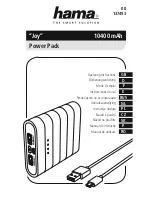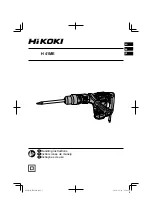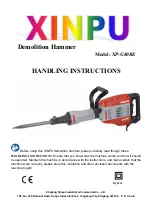
14 • ENGLISH
ENGLISH • 15
DO NOT RETURN THIS PRODUCT TO THE STORE,
first contact your local Black & Decker office
or nearest authorized service center.
GENERAL SAFETY RULES
Warning! Read and understand all instructions. Failure
to follow all instructions listed below, may result in electric
shock, fire and/or serious personal injury.
IMPORTANT SAFETY INSTRUCTIONS
WARNING:
f
Do not use RAPIDROLLER™ for purposes other than
described in this manual. Failure to do so may result in
injury to persons and or property damage.
f
For use only with water soluble and most oil based
paints and stains. Not for use with oil based paints and
stains that require cleaning solutions stronger than
mineral spirits (refer to label on original paint
container). Do not use with paint removers, or the like.
Liquids other than paint or stain may damage product
and result in injury to persons or property damage.
f
Read the label on the original paint container and
follow all directions. Failure to do so may result in
injury to persons or property damage.
f
Use proper eye protection and other safety equipment
for skin and respiratory protection when mixing the
paint, and when filling, using, and cleaning the
product. Paint and its fumes can cause personal
injury.
f
To reduce the risk of injury, use only in a well
ventilated area.
f
Thoroughly clean and rinse product after using with a
particular paint. Mixing different paints in the product
may result in property damage.
f
To reduce the risk of injury, use only recommended
accessories.
f
When servicing, use only identical replacement parts.
Failure to do so may result in personal injury.
Tips for painting with the RAPIDROLLER™
f
Only use a perforated roller cover. Standard roller
covers will not work.
f
Inspect roller cover for lint before painting, if needed
wash and dry before using.
f
When using the RAPIDROLLER™ for the
first application, it will take most of the paint in the
RAPIDROLLER™ ube to saturate the roller cover. A
second fill may be needed.
f
Keep roller moving while pushing plunger in or
squeezing trigger to prevent dripping.
f
Stop pushing plunger in or squeezing trigger if the
roller starts to skid, slide or drip.
f
When painting in tight areas partially fill
RAPIDROLLER™ or pivot the frame . This reduces its
overall length.
f
When leaving RAPIDROLLER™ unattended for a
longer period of time, wrap roller in a plastic bag to
prevent drying, removing as much air as possible from
bag.
f
Make sure the type of paint you use can be cleaned
with either mineral spirits (for oil-based paints) or a
warm water and soap solution (for water soluble paints
like latex).
f
Use drop cloths to protect your floors and anything
else in the room that you do not want accidentally
splattered with paint.
f
When using kickstand, always pivot head to straight
position and release pressure by pulling plunger out
slightly.
FEATURES (Fig. A)
1. Plunger
2. Handle Assembly
3. O-Rings
4. Duck Bill Valve
5. Wiper Seal
6. Orange Fill Cap Cover
7. Roller Frame
8. Inner End Cap
9. Roller Core
10. 3/8 in. perforated roller
11. Outer End Cap
12. Spatter Shield
13. Can Cover
14. Shroud
15. Fill Tube
16. Hose Extension Ribs
17. Petroleum Jelly
Preparing the RAPIDROLLER™ to paint
1. Lubricate part (1) and (3) using petroleum jelly
provided. Attach assembled roller (4) onto
RAPIDROLLER™ frame (2). Make sure roller
assembly snaps into locking clip on outer end cap (Fig. B).
2. Push roller frame (1) over end of handle assembly (4)
ensuring O-ring (2) is seated inside roller frame.
Thread handle assembly collar (3) snugly onto threads
of roller frame (1) (Fig. C).
3. The spatter shield helps reduce spatter when painting,
especially on ceilings. Position the spatter shield by
rotating around roller frame (Fig. D).
Note: Spatter shield is also helpful to prevent dripping
when
RAPIDROLLER™ is resting on kickstand and is
not in use. Just position spatter shield under roller.
Filling the RAPIDROLLER™ with paint
1. Insert the small end of the fill tube (1) through the hole
in the bottom side of the paint can cover (2).
Push in until tight and to the ridge of the fill tube (Fig. E).
2. Snap paint can cover onto paint can (Fig. F1). Lubricate
top of fill tube stem with a small amount of petroleum
jelly included in carton.
Note: The can cover will not fit on some paint
containers. It can be stretched over larger cans or
compressed slightly by squeezing to fit smaller cans.
To fill theRAPIDROLLER™ when the can cover does
not fit your paint
container, omit the can cover and place fill tube
directly into container. Hold the fill tube with hand to
stabilize as needed. A fill tube can clip is available as
an optional accessory for use with other size
containers. See “Accessories”. For deeper containers
like 5 gallon pails, fit a section of ¾ inch I.D. (inner
diameter) clear tubing over the ribs of the fill tube to
extend it (Fig. F2) and clip to side of pail with fill tube
can clip. Cut bottom end of tubing at slight angle.
Tubing is available at most hardware stores.
3. Hold the RAPIDROLLER™ at a 45 degree angle and
place the fill valve (1) over the fill tube. Gently push
the
RAPIDROLLER™ down until it bottoms
on the fill tube. MAKE SURE THE ORANGE FILL
CAP COVER (1) IS COMPLETELY COVERED BY
SHROUD OF CAN COVER (Fig. G).
Note: Remove cardboard spacer, and squeeze trigger
to free up the plunger. Pull plunger (2) all the way back
to draw paint into RAPIDROLLER™. (This may
take some force.) Once tube is full you are ready to
start painting. Lift RAPIDROLLER™ slowly off fill
tube.
Note: If you do not receive a complete fill the first
time, push plunger slowly to return paint to can and
then pull back plunger making sure angle is correct
and orange fill cap cover is fully seated.
Painting with the RAPIDROLLER™
1. Begin rolling on wall and push plunger handle or
squeeze trigger to feed paint into the roller cover.
Note: Initial saturation of the roller may require the full
amount of paint from the first fill. Fill RAPIDROLLER™
as needed (Fig. H).
Helpful hints
f
The trigger only needs to be squeezed when paint is
needed.
f
If you are getting a dot pattern when painting, apply
more paint.
f
If the roller is sliding on the surface, apply less paint.
f
You may notice petroleum jelly within the handle.
This is necessary and will help in its operation and will
not affect the paint.
2. The roller head can be adjusted to three different
angles. Press the orange button on the roller head to
change the angle from straight to 40 or 80 degrees.
Use straight on for general painting and 40 or 80
degree angles for hard to reach places or when
painting close to ceiling or edging (Fig. I1).
Note: The handle (1) can be rotated to make it more
comfortable when painting with an angled roller frame.
To rotate handle to desired position, loosen collar (2),
adjust handle and retighten collar (Fig I2).
3. When not in use rest the RAPIDROLLER™ on the
convenient kickstand (1) (Fig. J).
f
When using kickstand, RAPIDROLLER™ should
always be on a drop cloth (2) or over newspaper in
case of drips (Fig. K).
f
When painting, kickstand should be pointed away
from roller to avoid getting spatter on kickstand.
f
Always rotate roller to the straight position before
pacing on kickstand.
f
To prevent drips, relieve pressure on
RAPIDROLLER™ by pulling plunger out slightly.
Note: Attaching the spatter guard when using the
kickstand helps insure that any dripping paint is
contained.
Cleaning the RAPIDROLLER™
1. Pull plunger back to draw excess paint from roller
frame into tube (Fig. L).
Hint: Place thumb over orange fill cap cover (1) to
help remove the most paint from the frame prior to
pulling back plunger.
2. Return paint from RAPIDROLLER™ to can by holding
RAPIDROLLER™ at a 45 degree angle and pushing
fill valve onto fill tube until it bottoms on fill tube. Make
sure orange fill valve is completely covered by shroud
of can lid. Push plunger in until it stops (Fig. M).
3. Scrape excess paint into can from roller.
Remove the roller by grasping the outer end cap and
the roller frame and using your thumb on the opposite
hand to push the roller off as shown (Fig. N).
Hint: Wear disposable gloves or use a plastic bag
over roller to keep your hands clean.
4. Remove the inner end cap by inserting the metal
tube of the roller frame into the cap about 1 inch and
at an angle. Pull the roller frame gently towards you
(Fig. O). Remove the roller core. Empty any remaining
paint. Remove the outer cap by inserting the roller
frame into the roller and gently pushing the cap off
(Fig. P).
5. Remove the fill tube from the paint can lid and push
it directly into the fill valve. When cleaning water
soluble paints, submerge the fill tube into warm, soapy
water and pull the plunger in and out 5 or more times.
When using oil based paints, instead of water, use
proper cleaning solvent listed on manufacturers
container and dispose of properly (Fig. Q).




























